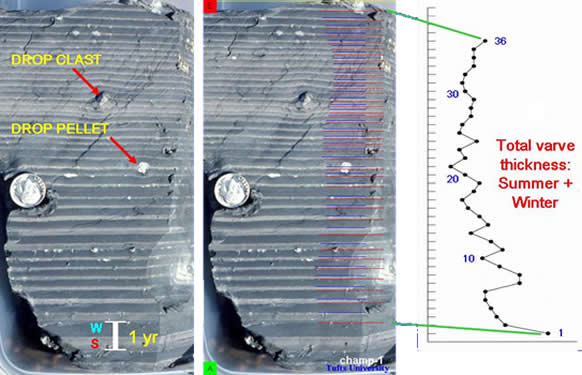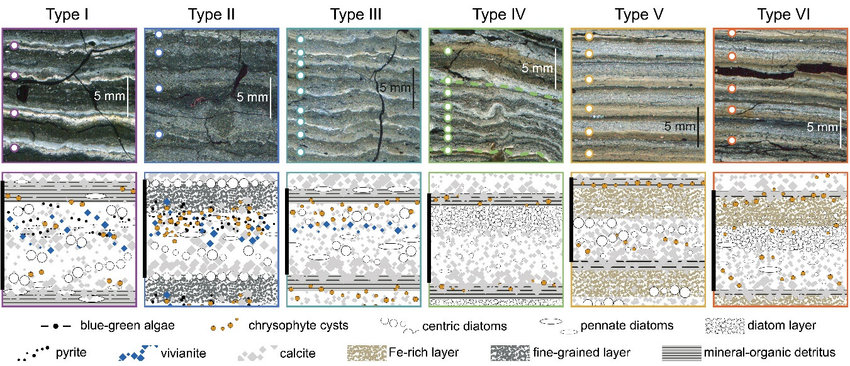Sedimentary Timekeepers
Varves are annual layers of sediment deposited in lakes, fjords, or marine environments. Each varve couplet typically consists of two distinct layers representing seasonal changes in deposition, providing a direct calendar-year timescale analogous to tree rings.
The Annual Couplet
A classic varve consists of:
- Summer Layer (Light): Coarser-grained sediment (silt, fine sand) deposited during higher energy periods, often associated with snowmelt runoff in glacial lakes or higher biological productivity in other lakes.
- Winter Layer (Dark): Finer-grained sediment (clay, organic matter) deposited slowly from suspension during calmer, often ice-covered winter conditions.
By counting these couplets, scientists can reconstruct chronologies spanning thousands, sometimes tens of thousands, of years.

Conditions for Varve Formation
The formation and preservation of distinct, countable varves require specific environmental conditions:
A strong seasonal difference in sediment input (type or amount) is crucial. This is common in glacial lakes (meltwater vs. winter settling), temperate lakes with distinct productivity cycles, or areas with seasonal rainfall patterns.
The lake bottom must be undisturbed by strong currents or biological activity (bioturbation). Anoxic (low oxygen) bottom conditions often prevent bottom-dwelling organisms from mixing the delicate layers.
Enough sediment must be deposited each year to form layers thick enough to be distinguished, but not so much that individual events overwhelm the seasonal signal.
The deposited layers must remain largely undisturbed after burial by subsequent layers to maintain the chronological integrity of the sequence.
Ideal Environments
Prime locations for varve formation include deep glacial lakes, fjords receiving glacial meltwater, deep temperate or boreal lakes with seasonal anoxia, and some marine basins.
Methodology: Coring and Counting
Varve chronologies are built through careful fieldwork and laboratory analysis:
- Coring: Specialized coring devices are used to extract undisturbed sediment sequences from the lake or basin floor. Multiple overlapping cores are often taken to ensure a complete record.
- Preparation: Cores are split, cleaned, and sometimes impregnated with resin to stabilize them for analysis.
- Counting & Measurement: Layers are meticulously counted under magnification. Techniques include visual identification, microscopic analysis of grain size and composition, high-resolution digital imaging, and X-ray fluorescence (XRF) scanning to detect subtle chemical variations defining layers. Varve thickness is measured precisely.
Microscopic Confirmation
Microscopic examination helps distinguish true annual layers from event layers (e.g., caused by floods or landslides) and identify features like pollen or diatom assemblages that confirm seasonality.

Building Longer Records: Cross-Dating
Similar to tree-ring dating (dendrochronology), individual varve sequences are often relatively short. Longer chronologies are constructed by matching patterns of thick and thin varves between overlapping cores from different locations within a lake or region.
Pattern Matching
Distinctive patterns of thick and thin varves, reflecting years of high or low runoff/productivity driven by regional climate variations, allow scientists to align sequences. A uniquely thin varve in one core should match a uniquely thin varve of the same calendar year in another nearby core.
Marker Layers
Distinct, widespread layers resulting from specific events, such as volcanic ash (tephra) layers or major flood deposits, serve as powerful isochrons (lines of equal time) to anchor and correlate different varve sequences.
Floating vs. Absolute Chronologies
A sequence matched internally but not tied to the present day is a "floating" chronology. By finding varves that extend to the present or can be linked to historically dated events or radiocarbon-dated material within the sequence, floating chronologies can be anchored to create an absolute calendar-year timescale.
Applications: Unlocking Past Environments
Dated varve sequences are powerful tools for reconstructing past conditions:
Paleoclimate Reconstruction
Varve thickness variations can track past precipitation, temperature (influencing melt), and runoff. Sediment properties, pollen, and microfossils reveal changes in vegetation, lake productivity, and water chemistry.
Geological & Environmental Events
Varves can precisely date earthquakes (via seismites or turbidites), floods, landslides, volcanic eruptions, and the onset of pollution.
Calibration of Radiocarbon Dating
Varve chronologies extending back through the early Holocene provide an independent timescale against which radiocarbon dates can be calibrated, improving the accuracy of ¹⁴C dating.
High-Resolution Records
Because they represent individual years, varves offer exceptionally high (annual or even seasonal) resolution for paleoenvironmental studies, allowing detailed investigation of rapid climate change and short-term events.
Limitations and Uncertainties
Despite their power, varve chronologies have limitations:
Specific Depositional Environments Required
Countable varves only form under specific conditions, limiting their geographic applicability compared to methods like radiocarbon dating.
Potential for Missing or Double Varves
Periods of non-deposition, erosion by bottom currents, or deposition of multiple pulses within a single year (e.g., from multiple storms) can lead to errors in the count if not carefully identified.
Disturbance
Bioturbation (mixing by organisms), slumping, or physical disturbances can disrupt the sequence, requiring careful site selection and analysis of multiple cores.
Counting Uncertainty
Identifying varve boundaries can sometimes be subjective, especially in sequences with subtle layering or disturbances. Uncertainty typically increases with age and the length of the counted sequence. Replication and cross-dating mitigate this.
Conclusion: A Precise Sedimentary Clock
Varve chronology provides an invaluable, high-resolution dating tool for reconstructing past environmental changes over thousands of years. Its reliability is founded on:
- Annual Deposition: The fundamental basis is the recording of the yearly seasonal cycle.
- Direct Counting: Like tree rings, it offers a direct year-by-year count where conditions permit.
- Cross-Dating & Replication: Matching patterns between multiple cores provides verification and extends records.
- Independent Verification: Correlation with marker beds (e.g., tephra) and calibration potential for other methods (e.g., ¹⁴C) enhances confidence.
Where applicable, varve sequences offer unparalleled detail about past climate variability, environmental events, and ecosystem responses, contributing significantly to our understanding of Earth system history.